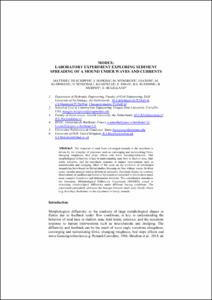MODEX: Laboratory experiment exploring sediment spreading of a mound under waves and currents

Visualitza/Obre
Estadístiques de LA Referencia / Recolecta
Inclou dades d'ús des de 2022
Cita com:
hdl:2117/181570
Tipus de documentText en actes de congrés
Data publicació2019
EditorWorld Scientific
Condicions d'accésAccés obert
Llevat que s'hi indiqui el contrari, els
continguts d'aquesta obra estan subjectes a la llicència de Creative Commons
:
Reconeixement-NoComercial-SenseObraDerivada 3.0 Espanya
Abstract
The dispersal of sand from submerged mounds in the nearshore is
driven by the interplay of processes such as converging and recirculating flows,
changing roughness, bed slope effects and wave focusing/refraction. This
morphological diffusivity is key to understanding sand bars in shallow seas, tidal
inlets, estuaries, and the nearshore response to human interventions such as
nourishments and dredging. Most of the work on the evolution of submerged
mounds has been based on fluvial studies, focusing on flow without waves. In these
cases, circular mounds tend to deform to crescentic (barchan) shapes. In contrast,
observations of sandbars and berms in the nearshore subjected to waves show much
more complex translation and deformation behavior. This contribution introduces
the laboratory MOrphological Diffusivity Experiment (MODEX) aimed at
examining morphological diffusivity under different forcing conditions. The
experiment particularly addresses the linkages between small scale (local) effects
(e.g. bed slope, bedforms) on the adjustment of sandy mounds.
Citacióde Schipper, M. [et al.]. MODEX: Laboratory experiment exploring sediment spreading of a mound under waves and currents. A: Coastal Sediments. "Coastal Sediments 2019: Proceedings of the 9th International Conference on Coastal Sediments". World Scientific, 2019, p. 511-524.
ISBN978-981-120-449-4
Versió de l'editorhttps://www.worldscientific.com/doi/abs/10.1142/9789811204487_0046
Col·leccions
| Fitxers | Descripció | Mida | Format | Visualitza |
|---|---|---|---|---|
| CS2019_proceedings_deSchipperetal.pdf | CS2019_proceeding_deSchipperetal | 4,956Mb | Visualitza/Obre |


